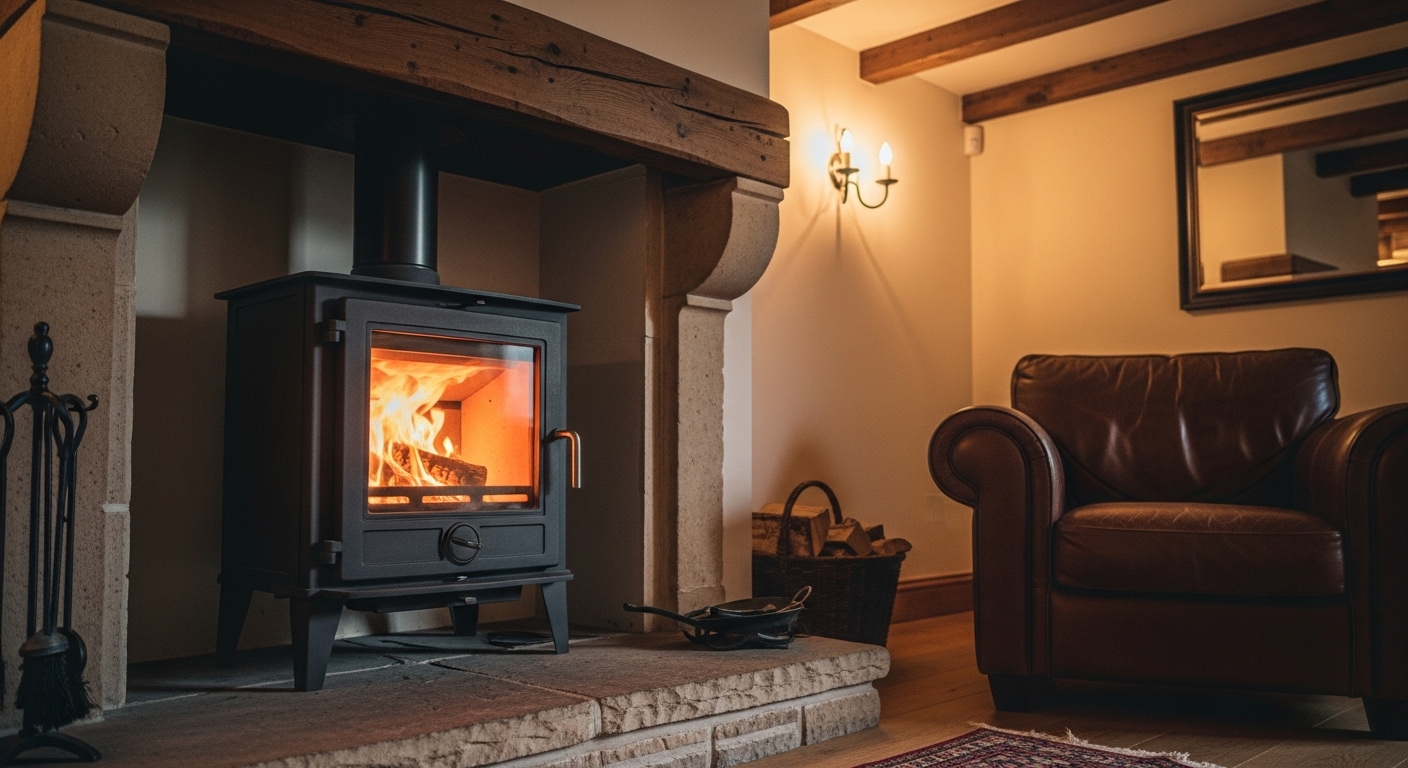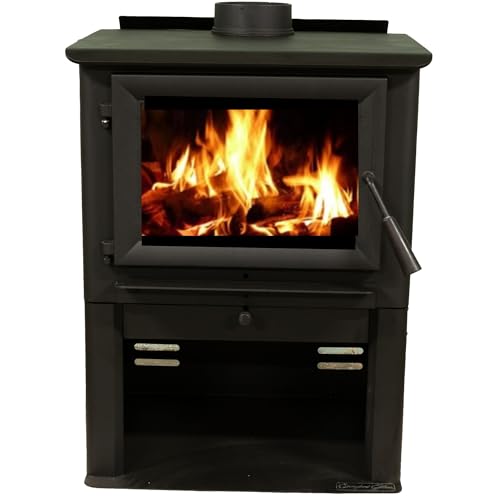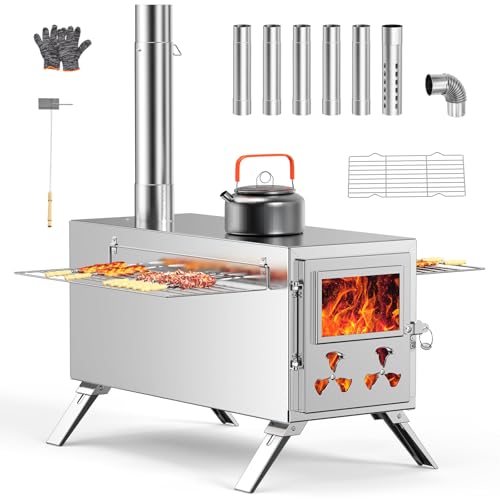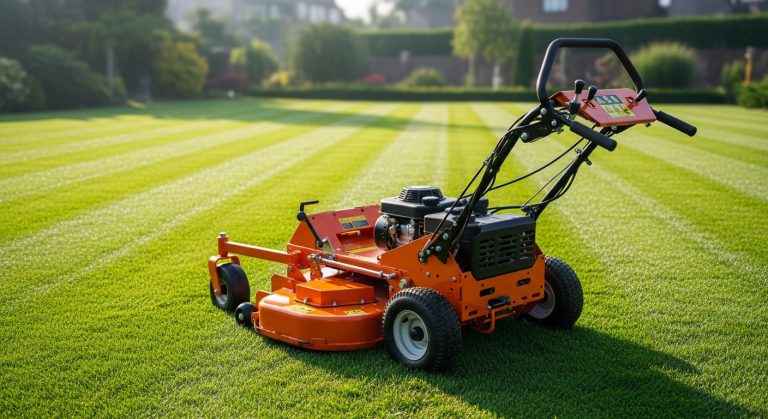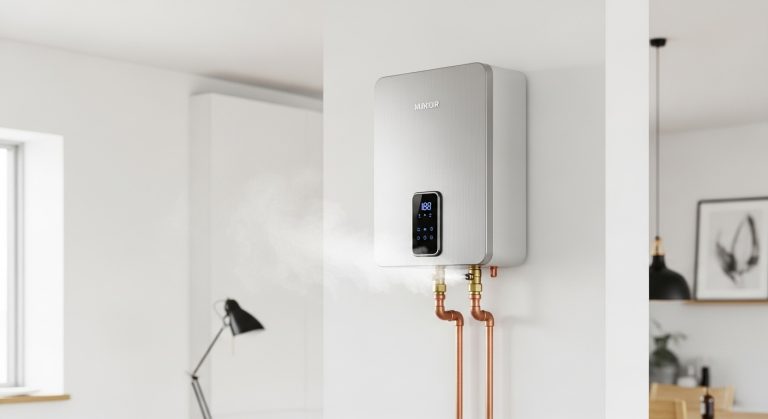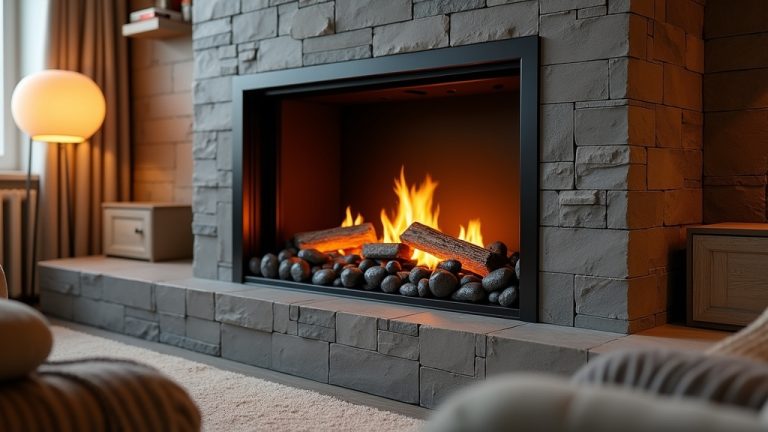Best Wood Burning Stoves: Ultimate Guide for 2026
Transform your home’s heating system with the revolutionary efficiency and warmth that only the best wood burning stoves can provide.
Modern wood burning stoves deliver 75-80% efficiency rates, triple-burn combustion technology, and can heat spaces up to 2,500 square feet while reducing heating costs by up to 50% compared to traditional heating methods.
These advanced heating appliances combine cutting-edge cleanburn systems with timeless comfort, offering homeowners an eco-friendly solution that burns cleaner, lasts longer, and provides consistent heat output.
Whether you’re seeking primary heating for your entire home or supplemental warmth for specific areas, this comprehensive guide reveals the essential features, sizing requirements, and advanced technologies that separate premium stoves from basic models, ensuring you make the smartest investment for decades of reliable, cost-effective heating.
Key Takeaways
- Efficiency is Everything – Choose stoves with 75% or higher efficiency ratings and EPA certification to maximize heat output while minimizing fuel consumption and environmental impact.
- Size Matters for Performance – Calculate your heating needs based on 20-30 BTUs per square foot for well-insulated homes, with higher requirements for poorly insulated spaces or extreme climates.
- Advanced Technology Delivers Results – Modern features like cleanburn technology, triple-burn systems, and airwash systems significantly improve efficiency, reduce emissions, and enhance the user experience.
- Fuel Quality Determines Success – Use only seasoned hardwoods with moisture content below 20% for optimal burning, maximum heat output, and minimal creosote buildup in your chimney.
- Professional Installation Ensures Safety – Proper installation by certified professionals guarantees code compliance, optimal performance, and safe operation while handling necessary permits and clearance requirements.
- Regular Maintenance Extends Lifespan – Annual chimney cleaning, monthly deep cleaning during burning season, and proper ash removal can help quality stoves last 20-30 years or more with consistent performance.
- Multi-Fuel Options Provide Flexibility – Consider multi-fuel capabilities if you want the versatility to burn both wood and approved smokeless fuels, though wood-only stoves typically offer superior wood-burning performance.
About Wood Burning Stoves
Wood burning stoves represent one of the most efficient and eco-friendly heating solutions available today. These appliances consist of a solid metal firebox, typically made from cast iron or steel, designed to contain and control the combustion process for maximum heat output.
Modern wood stoves operate through a sophisticated combustion system that maximizes fuel efficiency while minimizing emissions. The process begins with primary combustion, where the solid wood burns and produces heat, gases, and particles. Advanced models feature secondary combustion technology that burns these gases at higher temperatures, extracting even more heat from the same amount of fuel.
How Wood Stoves Work?
The combustion chamber serves as the heart of any wood burning stove. Here, seasoned logs with moisture content below 20% burn efficiently to produce consistent heat. The air control systems allow you to regulate the burning rate, giving you precise control over heat output and fuel consumption.
Heat distribution occurs through two primary methods: radiant heat directly from the stove’s hot surfaces, and convection heat where cool air is drawn in, heated, and circulated back into the room. This dual approach ensures even temperature distribution throughout your living space.
Benefits of Wood Burning Stoves
Wood stoves offer significant cost savings compared to traditional heating methods. They provide independence from fluctuating energy prices while using a renewable fuel source. The atmospheric benefits include creating a warm, inviting ambiance that electric or gas heating simply cannot match.
Environmental advantages make wood stoves an excellent choice for eco-conscious homeowners. When properly operated with seasoned wood, they produce minimal emissions while utilizing a carbon-neutral fuel source. Modern EPA-certified stoves burn so efficiently that they produce very little smoke or ash.
Essential Features to Look For
Efficiency Ratings
High efficiency ratings should be your top priority when selecting a wood burning stove. Look for models with efficiency ratings of 75% or higher. These stoves convert more fuel into usable heat, reducing wood consumption and operating costs significantly.
EPA certification ensures your stove meets strict environmental standards for emissions and efficiency. Certified stoves burn cleaner and produce more heat per log, making them both economically and environmentally superior choices.
Combustion Technology
Cleanburn technology introduces pre-heated air into the combustion chamber to burn off excess hydrocarbons in the smoke. This process increases efficiency while dramatically reducing emissions, creating a cleaner burn with less environmental impact.
Triple-burn systems represent the pinnacle of combustion technology. These systems ensure complete fuel combustion by recirculating wood gases, smoke, and particles back into the fire. The result is maximum heat extraction from every log with minimal waste.
Air Control Systems
Primary air controls regulate airflow into the main combustion chamber, allowing you to control the burning rate and heat output. Secondary air controls in advanced stoves manage the air supply for secondary combustion, optimizing efficiency and reducing emissions.
Automatic air control features in premium models adjust airflow based on combustion conditions. These systems maintain optimal burning conditions without constant manual adjustment, ensuring consistent performance and maximum efficiency.
Choosing the Right Size
Calculating Heat Requirements
Proper sizing is crucial for optimal performance and efficiency. A stove that’s too small won’t adequately heat your space, while an oversized unit will burn inefficiently and waste fuel. Calculate your heating needs based on square footage, ceiling height, and insulation quality.
BTU requirements typically range from 20-30 BTUs per square foot for well-insulated homes. Homes with poor insulation, high ceilings, or large windows may require 40-50 BTUs per square foot. Consider your climate zone and typical winter temperatures when making calculations.
Room Size Considerations
Small rooms (up to 1,000 square feet) work best with compact stoves producing 20,000-40,000 BTUs. These units provide adequate heat without overwhelming the space or creating uncomfortable temperature swings.
Medium to large spaces (1,000-2,500 square feet) require stoves with 40,000-80,000 BTU capacity. These powerful units can serve as primary heating sources for substantial areas while maintaining consistent temperatures throughout.
Open floor plans and homes with cathedral ceilings need careful consideration. Heat rises and spreads differently in these spaces, often requiring higher BTU ratings or strategic placement for optimal heat distribution.
Combustion Chamber Size
Larger combustion chambers accommodate bigger logs and longer burn times, reducing the frequency of refueling. However, they require higher minimum heat output to burn cleanly, making them less suitable for mild weather operation.
Smaller chambers excel at clean burning at lower outputs, making them ideal for shoulder seasons or well-insulated homes. They heat up quickly and provide responsive temperature control for varying heating needs.
Top Wood Stove Types
Traditional Cast Iron Stoves
Cast iron construction provides excellent heat retention and even temperature distribution. These stoves continue radiating heat long after the fire dies down, making them incredibly efficient for consistent warmth. The classic aesthetic complements traditional and rustic home designs perfectly.
Durability stands as the hallmark of cast iron stoves. With proper maintenance, these units can last decades while maintaining their performance and appearance. The thick walls provide superior heat retention compared to steel alternatives.
Steel Wood Stoves
Steel construction offers faster heat-up times and lighter weight compared to cast iron. These stoves respond quickly to air control adjustments, providing immediate temperature changes when needed. Modern steel stoves feature advanced insulation for improved efficiency.
Contemporary designs in steel stoves suit modern home aesthetics. Clean lines and sleek finishes integrate seamlessly with contemporary décor while providing the same heating performance as traditional styles.
Insert Stoves
Fireplace inserts transform existing fireplaces into efficient heating systems. These units fit directly into your current fireplace opening, dramatically improving heating efficiency while maintaining the visual appeal of a traditional fireplace.
Installation advantages make inserts attractive for homes with existing chimneys. They typically require less modification to your home’s structure while providing significant efficiency improvements over open fireplaces.
Cylindrical Stoves
Modern cylindrical designs offer 360-degree heat radiation and striking visual appeal. These stoves often feature large glass panels providing excellent flame viewing from multiple angles. Their compact footprint makes them ideal for smaller spaces.
Innovative features in cylindrical stoves include rotating bases and wrap-around glass doors. These design elements enhance both functionality and aesthetic appeal while maintaining excellent heating performance.
Advanced Technologies
Airwash Systems
Airwash technology uses carefully directed airflow to keep the glass door clean during operation. This system draws cool air down across the inside of the glass, preventing soot buildup and maintaining clear flame visibility throughout the burn cycle.
Improved viewing experience results from consistently clean glass, allowing you to enjoy the mesmerizing flames without frequent cleaning. This feature enhances both the practical and aesthetic benefits of your wood stove.
Smart Features
Automatic start functions control airflow through the grate, allowing you to keep the door closed while kindling the fire. This innovation makes stoves independent of ambient air and ideal for modern homes with negative pressure issues.
Refueling boost functions revive dying embers with oxygen-rich air flow from below. Simply release the handle to blow life into embers, making it easy to restart your fire without completely rebuilding it from scratch.
Multi-Fuel Capabilities
Multi-fuel grates allow you to burn both wood and approved smokeless fuels in the same stove. This versatility provides fuel flexibility and ensures you can always find suitable fuel regardless of local availability or regulations.
Conversion options let you switch between wood-only and multi-fuel operation as needed. This adaptability makes your stove investment more versatile and valuable over its lifetime.
Installation Considerations
Chimney Requirements
Proper chimney sizing ensures adequate draft for efficient combustion and safe operation. The chimney should be at least the same diameter as the stove’s flue outlet, with sufficient height to create proper draft conditions.
Chimney condition directly affects stove performance. A well-maintained chimney with proper insulation and structural integrity is essential for safe, efficient operation. Poor chimneys can cause performance issues and safety hazards.
Clearance Requirements
Safety clearances from combustible materials are mandated by building codes and manufacturer specifications. These requirements ensure safe operation and prevent fire hazards. Proper clearances typically range from 12-36 inches depending on the stove and installation type.
Floor protection requirements vary based on stove type and local codes. Non-combustible hearth pads protect flooring from heat and sparks while meeting safety requirements. Size requirements depend on stove dimensions and door opening direction.
Professional Installation
Certified installers ensure your stove meets all safety codes and operates at peak efficiency. Professional installation includes proper chimney connection, clearance verification, and safety system testing.
Permit requirements vary by location but are typically required for wood stove installations. Professional installers handle permit applications and code compliance verification, ensuring your installation meets all legal requirements.
Maintenance and Care
Regular Cleaning
Ash removal should occur regularly to maintain proper airflow and prevent ash buildup that can damage stove components. Cool ash disposal in metal containers away from combustible materials prevents fire hazards.
Glass cleaning maintains visibility and aesthetic appeal. Use appropriate glass cleaners designed for wood stove glass, avoiding household cleaners that can damage the special high-temperature glass.
Seasonal Maintenance
Annual chimney cleaning removes creosote buildup and ensures safe operation. Professional chimney sweeps can identify potential issues before they become serious problems, maintaining optimal performance and safety.
Gasket inspection ensures proper door sealing for efficient combustion. Worn gaskets allow air leaks that reduce efficiency and can cause performance problems. Replace gaskets when they show signs of wear or damage.
Component Care
Firebrick maintenance involves inspecting and replacing damaged fire bricks that protect the stove’s metal components. Cracked or missing bricks can cause heat damage to the stove body and reduce efficiency.
Air control maintenance keeps dampers and air controls operating smoothly. Regular lubrication and adjustment ensure precise control over combustion air and optimal stove performance.
Fuel Selection and Storage
Choosing the Right Wood
Seasoned hardwoods provide the best heat output and burning characteristics. Oak, maple, hickory, and ash offer excellent heat content and burn cleanly when properly seasoned. Avoid softwoods for primary heating as they burn quickly and produce more creosote.
Moisture content should be below 20% for optimal burning. Wet wood burns inefficiently, produces excessive smoke, and creates dangerous creosote buildup in chimneys. Use a moisture meter to verify wood dryness before burning.
Proper Storage
Covered storage protects wood from rain and snow while allowing air circulation for continued drying. Elevated storage prevents ground moisture absorption and improves air circulation around the wood pile.
Seasoning time varies by wood type and climate but typically requires 6-12 months for proper drying. Split wood dries faster than whole logs, and smaller pieces season more quickly than large chunks.
Fuel Preparation
Proper splitting creates uniform pieces that burn consistently and fit easily in your stove. Consistent sizing ensures predictable burn times and heat output, making it easier to maintain desired temperatures.
Kindling preparation involves creating small, dry pieces for easy fire starting. Proper fire building techniques using newspaper, kindling, and gradually larger pieces ensure quick, clean ignition without excessive smoke.
Frequently Asked Questions
What size wood burning stove do I need for my home?
Stove sizing depends on your home’s square footage, insulation quality, and ceiling height. Most homes need 20-30 BTUs per square foot for adequate heating.
Well-insulated homes can use the lower end of this range, while older homes with poor insulation may need 40-50 BTUs per square foot. Consider your climate and typical winter temperatures when calculating requirements.
How often should I clean my wood burning stove?
Regular maintenance includes removing ash weekly during heavy use and cleaning glass as needed for visibility. Deep cleaning should occur monthly during burning season.
Annual professional service includes chimney cleaning and complete stove inspection. This prevents creosote buildup and identifies potential issues before they become serious problems.
Can I burn any type of wood in my stove?
Seasoned hardwoods work best for heating, providing maximum heat output and clean burning. Avoid green or wet wood which burns inefficiently and creates excessive creosote.
Softwoods like pine can be used occasionally but burn quickly and produce more resin. Never burn treated lumber, painted wood, or garbage as these materials release toxic fumes and can damage your stove.
What’s the difference between wood-only and multi-fuel stoves?
Wood-only stoves lack grates and burn wood directly on the firebox floor. They’re optimized specifically for wood combustion and typically offer better wood-burning performance.
Multi-fuel stoves include grates and ash pans, allowing you to burn both wood and approved smokeless fuels. This versatility provides fuel flexibility but may compromise optimal wood-burning efficiency.
How long do wood burning stoves typically last?
Quality stoves with proper maintenance can last 20-30 years or more. Cast iron stoves often outlast steel models due to their superior heat retention and durability.
Regular maintenance significantly extends stove life. Annual cleaning, proper operation, and timely repairs prevent premature wear and ensure decades of reliable service from your investment.
Make Your Home Warmer Today
Investing in the right wood burning stove transforms your home into a warm, comfortable sanctuary while reducing heating costs significantly. The advanced technologies and efficient designs available today make wood stoves cleaner, more powerful, and easier to operate than ever before.
With proper selection based on your specific needs, you’ll enjoy decades of reliable heating while adding timeless charm to your living space. Don’t let another cold season pass without the comfort and savings that only the best wood burning stoves can provide.

